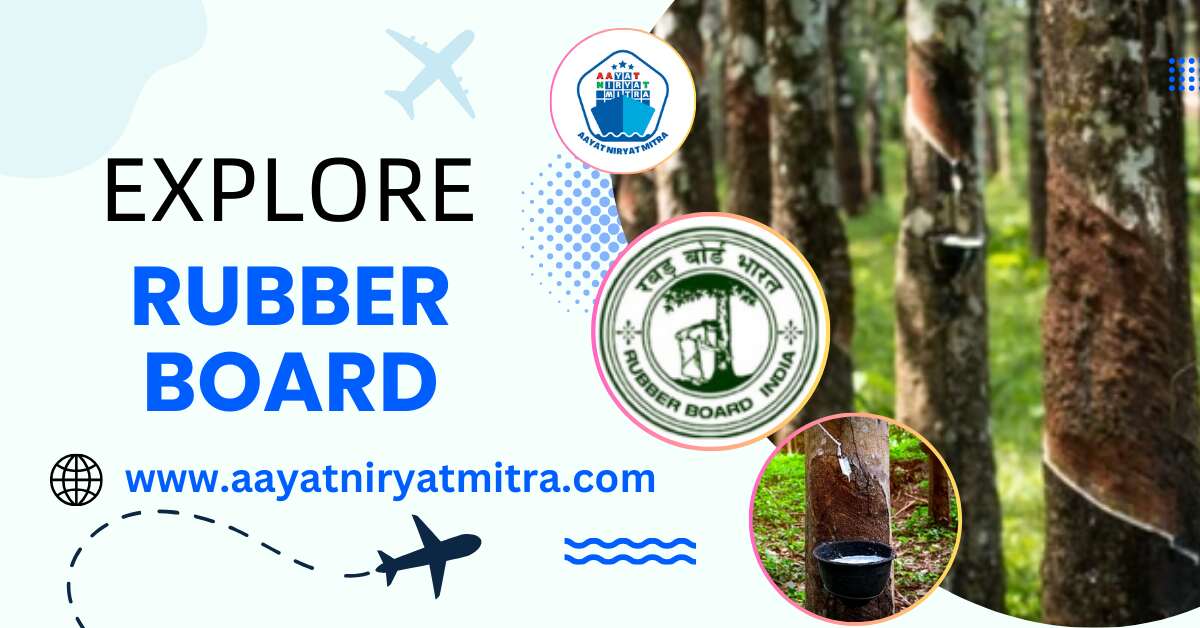India celebrated for its rich agricultural bounty, is a significant contributor to the global natural rubber (NR) export market. If you’re contemplating stepping into the realm of exporting Indian NR, this blog is your ultimate companion. Here, we’ll navigate through the prime importers of Indian NR and uncover the invaluable assistance provided by the Rubber Board of India.
Introduction:
The primary type of natural rubber exported in India is Natural Rubber (NR). However, depending on processing methods and quality parameters, NR comes in various forms. Let’s break it down:
Forms based on processing
- Ribbed Smoked Sheet (RSS): This is the most common form of NR exported from India. It involves coagulating latex and rolling it into sheets for drying and smoking. RSS comes in different grades depending on visual quality and processing methods.
- Technically Specified Rubber (TSR): This form undergoes further processing to achieve specific physical properties like Mooney viscosity, which measures rubber’s flow characteristics. It’s tailored to meet specific industry requirements.
- Crepe Rubber: This variety goes through a longer creping process to attain a cleaner and more uniform appearance compared to RSS. It’s often preferred for applications that require higher value.
- Latex: Although less common due to transportation and storage challenges, unprocessed liquid latex is also exported in some cases.
Forms based on quality parameters:
- Grades: NR is assigned grades by the Rubber Board based on visual inspection and laboratory testing. These grades indicate factors like cleanliness, presence of impurities, and overall quality. Common grades include RSS 1, RSS 3, and TSR 20.
- Standards: NR can also be categorized based on adherence to national or international standards, such as Indian Standard (IS) specifications and the Standard Malaysian Rubber (SMR) Scheme. These standards ensure consistent quality for buyers. Understanding these different forms and classifications ensures that you source and export the most suitable type of natural rubber to meet the specific needs of your international buyers.
Top Importers with a Hunger for Indian Rubber
Indian rubber holds indispensable value across various industries worldwide. Here’s a glimpse at some leading importers:
- United States: A major importer of both natural and reclaimed rubber, widely used in tires, hoses, and more.
- China: With its burgeoning automotive sector, China fuels a soaring demand for natural rubber.
- European Union (EU): Nations like Germany and Italy heavily import natural rubber for diverse industrial applications.
- Japan: Known for its precision manufacturing, Japan imports substantial quantities of high-quality natural rubber.
- South Korea: With a robust automotive industry, South Korea seeks both natural and reclaimed rubber in ample amounts.
Understanding these prominent markets empowers you to tailor your export strategy effectively to cater to specific demands.
Also Read | How to Start Exports
Also Read | Incoterms 2020
Also Read | Payment Terms for Exports
Also Read | Commodity Board of India
The Rubber Board: Your Partner for a Resilient Export Journey
Founded in 1947, the Rubber Board of India plays a pivotal role in fostering and nurturing the Indian rubber industry. Membership offers exporters a plethora of advantages:
- Market Access and Promotion: Gain entry to international trade fairs, buyer-seller meets, and marketing resources, expanding your market reach.
- Technical Assistance and Training: Access expert knowledge and training sessions covering cultivation, processing, export regulations, and quality assurance.
- Certification Schemes: Utilize the Rubber Board’s certification schemes to ensure your rubber meets global quality benchmarks.
- Networking Opportunities: Forge connections with industry peers, fostering collaborations and knowledge exchange.
- Policy Advocacy: The Rubber Board advocates for your interests before the government, influencing policies favoring exporters.
Rubber Board Membership: Required Documents and Fees, Validity
The Government of India has entrusted the Rubber Board with the responsibility of being the Export Promotion Council (EPC) for issuing the Registration-Cum-Membership Certificate (RCMC) for Natural Rubber exports. To become a member of the EPC and obtain the RCMC, exporters can apply to the Board. Only registered exporters with a valid RCMC are eligible for the benefits outlined in the current Exim policy.
Conditions for Obtaining RCMC:
- The applicant must hold a valid license as a rubber dealer or rubber processor.
- The applicant must possess a valid Import and Export (IE) Code Number.
Documents Required for RCMC:
- A self-attested copy of the IE Code Number.
- A Bank Certificate confirming the financial stability of the applicant.
- A self-attested copy of the Dealers/Processors License issued by the Rubber Board.
- For companies registered under the Companies Act, a copy of the Memorandum and Articles of Association, along with any alterations made, should be provided. In the case of partnerships, a copy of the partnership deed is required.
Additional Terms and Conditions:
- All registered exporters must submit a monthly export statement to the Dy. Director (Marketing) at the Rubber Board’s office in Kottayam-9 by the 5th of the following month. A NIL statement is required for any period with no export activity.
- For RCMC renewal, the existing certificate must be surrendered with the renewal application, available upon request from the issuing office.
- The fee for new or renewal RCMC registration as a Natural Rubber exporter is Rs. 5000 plus service tax, and its validity is for 5 years.
Registration Fees for RCMC
- New: Rs. 5900/- (Rs. 5000.00 + 18 % GST)
- Renewal: Rs. 5900/- (Rs. 5000.00 + 18 % GST)
RCMC of Natural Rubber exporter validity is for 5 years.
FAQs on Natural Rubber Export from India
-
Q: What are the different types of natural rubber exported from India?
Ans: India primarily exports two types of natural rubber:
Natural Rubber (NR): This is the most common type, derived from latex extracted from rubber trees. India exports various grades of Natural Rubber
1. Processing methods
2. Quality parameters. -
Q: Which countries are the major importers of Indian natural rubber?
Ans: Major importers include:
1. United States
2. China
3. European Union (Germany, Italy)
4. Japan
5. South Korea -
Q: What are the essential steps involved in exporting natural rubber from India?
Ans: 1. Obtain an Exporter’s License from the government.
2. Register with the Rubber Board (optional but recommended) for benefits like certification and market access support.
3. Source high-quality NR that meets international quality standards and specific buyer requirements.
4. Ensure proper packaging and labeling that complies with international regulations and protects the rubber during transport.
5. Find reliable international buyers through trade fairs, online platforms, or industry connections.
6. Arrange for customs clearance, logistics, and necessary documentation. -
Q: Is Rubber Board membership mandatory for all natural rubber exporters?
Ans: No, membership isn’t mandatory but offers significant advantages.
-
Q: What are the benefits of being a member of the Rubber Board of India?
Ans: 1. Access to certification schemes for quality and origin verification (e.g., Standard Malaysian Rubber (SMR) Scheme).
2. Participation in trade fairs and buyer-seller meets facilitated by the Board.
3. Market research and intelligence reports to stay informed about global trends.
4. Technical assistance and training on various aspects of rubber processing and export.
5. Access to dispute settlement mechanisms for export-related issues. -
Q: What are the fees and validity of Rubber Board membership (RCMC)?
Ans: Fees and validity vary based on the membership category (exporter, processor, etc.). Refer to the Natural Rubber Board website for current details (http://www.indiannaturalrubber.com/).
-
Q: What are the key quality certifications for exporting Indian natural rubber?
Ans: The Rubber Board offers various certification schemes to ensure adherence to international standards. These include:
Standard Malaysian Rubber (SMR) Scheme
Technically Specified Rubber (TSR) Scheme
Indian Standard (IS) Certification for specific rubber grades -
Q: How can I find reliable international buyers for Indian natural rubber?
Ans: 1. Attend trade fairs and buyer-seller meets organized by the Rubber Board.
2. Utilize online platforms specializing in the rubber trade.
3. Network with industry associations and participate in relevant events.
4. Consider online marketplaces or direct outreach to international buyers. -
Q: What are some challenges faced by Indian natural rubber exporters?
Ans: 1. Fluctuations in global NR prices.
2. Competition from major rubber-producing countries like Thailand and Indonesia.
3. Meeting stringent quality standards of importing countries.
4. High logistics costs for NR exports.
5. Fluctuations in domestic NR production due to weather and other factors. -
Q: What resources are available to help me learn more about Indian natural rubber exports?
Ans: The Rubber Board of India website (http://www.indiannaturalrubber.com/) and (http://rubberboard.org.in/) offers comprehensive information on regulations, certifications, export procedures, and market insights. Government export promotion agencies and industry associations provide resources and guidance. Online publications and industry reports can offer valuable insights into global rubber market trends.
Conclusion
By venturing into Indian rubber exports, you contribute to a vital global industry. Partnering with the Rubber Board equips you with the expertise, resources, and connections needed to navigate the global rubber market seamlessly. So, set sail on your Indian rubber export journey today and leave your imprint on the global stage!
If you discover an error in the “Natural Rubber Board | Rubber Board: A Comprehensive Guide 2024“ information provided to us, please notify us immediately via the comment box and email; if the information provided by you is correct, We will change it.
If you enjoyed this article, please share it with your friends. Please visit Aayat Niryat Mitra | Import Export Friend for more information on this and other topics. Thank you for stopping by.

